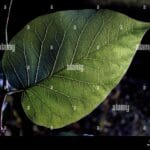Strangler figs, a group of Ficus species, are renowned for their unusual life cycle and significant ecological impact. From a tiny seed deposited high in a rainforest canopy to a massive, independent tree, their journey is a story of adaptation, competition, and surprising symbiotic relationships.
From Epiphyte to Giant: The Strangler Fig’s Life Cycle
The strangler fig’s life cycle begins with a seed, often carried by birds or other animals, finding a home in the crevices of a host tree’s bark. This seemingly innocuous beginning sets the stage for a dramatic transformation. Did you know that the verdant foliage of the green vase zelkova contrasts beautifully with the variegated leaves of its companion, the dracaena spike? Unlike most plants that root in the ground, the strangler fig begins as an epiphyte, a plant that grows on another plant for physical support.
Aerial Root Descent and Host Encirclement
The germinated seed sends out aerial roots that descend towards the forest floor. These roots, clinging to the host tree’s bark, gradually thicken and intertwine, forming a network that encases the host. This “embrace,” while seemingly benign at first, eventually restricts the host tree’s growth. As the fig’s aerial roots reach the ground, they establish a connection to the soil, providing access to vital nutrients and water. This allows the strangler fig to accelerate its growth, further tightening its grip on the host tree.
The Fate of the Host and the Fig’s Independence
The fate of the host tree is variable. Some research suggests that strangler figs may provide structural support to their host trees, indicating a potential mutualistic relationship. In other cases, the host tree may decline, potentially due to shading by the fig’s dense canopy and girdling by the fig’s roots, which restrict nutrient and water transport. If the host tree succumbs, the strangler fig, now a freestanding tree, often has a hollow core where the host once stood. This unusual structure, sometimes large enough for a person to stand inside, provides a visual reminder of the fig’s dramatic life cycle. This adaptability and potential mutualism challenge the traditional view of strangler figs as solely parasitic plants.
A Diverse Family: Exploring Strangler Fig Species
The term “strangler fig” encompasses a variety of Ficus species, each with its own unique characteristics. Ficus aurea, also known as the Florida strangler fig, is a prominent example found in Florida, the Caribbean, and parts of Central and South America. Another well-known species is Ficus benghalensis, the banyan fig, native to India. While both are strangler figs, they exhibit distinct features, highlighting the diversity within this fascinating group.
Ficus aurea: Florida’s Iconic Strangler
Ficus aurea is recognized for its rapid growth, often exceeding 60 feet in height in just a few decades. Its small, round fruits, roughly the size of a grape, offer a sweet yet slightly tart flavor, making them a popular ingredient in local cuisine.
Ficus benghalensis: The Majestic Banyan
Ficus benghalensis, in contrast, produces much larger fruits, up to six inches in diameter. These sweet and juicy fruits are enjoyed both fresh and in various dishes, such as curries. Banyan figs are also known for their extensive aerial root systems, which can create a network of interconnected trunks, giving the appearance of a single, massive tree.
Ecological Roles: More Than Just a “Killer”
While the name “strangler fig” evokes an image of a parasitic killer, their ecological role is much more complex. Strangler figs are keystone species in many tropical and subtropical forests, contributing significantly to biodiversity and ecosystem dynamics.
Food Source and Habitat Provider
The fruits of strangler figs are a vital food source for a wide range of animals, from monkeys and birds to insects and bats. Their dense canopies provide nesting sites for birds and shelter for various other creatures. The hollow cores of mature strangler figs can even serve as dens for larger animals.
Impact on Forest Structure and Seed Dispersal
Strangler figs play a role in forest succession, influencing the structure and composition of the forest over time. By creating gaps in the canopy as they mature, they allow sunlight to reach the forest floor, promoting the growth of other plant species. They also contribute to seed dispersal through their fruit production, attracting animals that consume the figs and distribute the seeds throughout the forest.
The Fig-Wasp Symbiosis: A Remarkable Partnership
A crucial aspect of strangler fig reproduction is its intricate symbiotic relationship with fig wasps. These tiny insects, no larger than a grain of rice, are the sole pollinators of fig flowers. In return, the fig provides a safe haven for the wasps to lay their eggs within the developing fruit. This co-evolutionary dance is essential for the survival of both species, highlighting the interconnectedness of life in the rainforest.
Ongoing Research and Future Directions
Scientists continue to study the complex relationships between strangler figs and their environment. Ongoing research explores the nuances of their growth patterns, their impact on forest dynamics, and their intricate interactions with other species. These studies are essential for understanding the vital role strangler figs play in maintaining the health and biodiversity of tropical and subtropical ecosystems.
- Revolution Space: Disruptive Ion Propulsion Transforming Satellites - April 24, 2025
- Race Through Space: Fun Family Game for Kids - April 24, 2025
- Unlocking the Universe: reading about stars 6th grade Guide - April 24, 2025
















